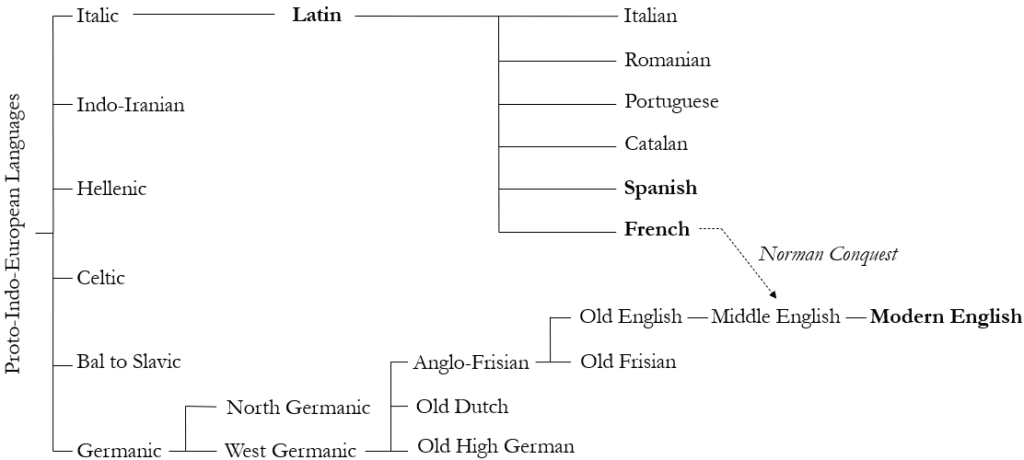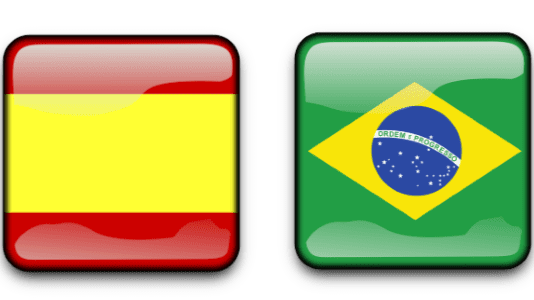Spanish and Portuguese are two of the most popular languages to learn. They are spoken in many different countries around the world. Most speakers of both languages are geographically located in the Iberian Peninsula and South America. In this article, we will discuss learning both Spanish and Portuguese at the same time.
Table of Contents
- Are Spanish and Portuguese Similar?
- Why Are Spanish and Portuguese Known as Romance Languages?
- Is Spanish Easy to Learn? Is Portuguese Easy to Learn?
- Is Learning Spanish or Portuguese Easier?
- Anki Best Flashcard App – Learn Spanish & Portuguese at the Same Time
- Conclusion
Spanish has approximately 485 million native speakers and is an official language in 21 countries. On the other hand, Portuguese has about 236 million native speakers and is an official language in 10 countries.
This article will explore the similarities and differences between Spanish and Portuguese. We will also discuss learning Spanish and Portuguese using Anki, the best flashcard app.
Are Spanish and Portuguese Similar?
Yes, Spanish and Portuguese are very similar languages. They are both Romance languages that are descended from Latin. As a result, the two languages share a lot of vocabulary and grammar, such as verb conjugation rules and sentence structure.
Spanish and Portuguese Similarities
A high percentage of words in Spanish and Portuguese are very similar. The lexical similarity between the two languages is about 90%. In comparison, Spanish and Portuguese share less than 30% lexical similarity with English.
For example, the Spanish word for “book” is “libro,” and the Portuguese word is “livro.” Both words are derived from the Latin word “liber.”
Here are some examples of Spanish and Portuguese cognates with Latin roots:
| Spanish | Portuguese | Latin | English |
| amigo | amigo | amicus | friend |
| amor | amor | amor | love |
| mar | mar | mare | sea |
| verdad | verdade | veritas | truth |
| mundo | mundo | mundus | world |
| luna | lua | luna | moon |
In some cases, Spanish and Portuguese have shared vocabulary derived from languages other than Latin. For example, it is estimated that 8% (or about 4,000 words) of the Spanish vocabulary can be traced back to the Arabic language. The Spanish language was strongly influenced by Arabic during the seven centuries of Moorish rule of Spain from the 8th to the 15th century. This influence has also found its way into the Portuguese language but to a lesser extent. Some lexical differences and vocabulary divergence between Spanish and Portuguese can be attributed to the lesser influence of Arabic on Portuguese than on Spanish.
Here are some examples of Spanish and Portuguese cognates with Arabic roots:
| Spanish | Portuguese | Arabic | English |
| albaricoque | abricó | al barqūq (أَلْبَرْقُوق) | apricot |
| café | café | qahwah (قهوة) | coffee |
| algodón | algodão | qutun (قطن) | cotton |
Notice the similarity in the sentence structure between Spanish and Portuguese in the following examples:
| SP | ¿Dónde está él? | Where is he? |
| PT | Onde está ele? | |
| SP | Yo estoy aquí. | I am here. |
| PT | Eu estou aqui. | |
| SP | Yo no sé donde están las llaves. | I do not know where the keys are. |
| PT | Eu não sei onde estão as chaves. |
Differences between Spanish and Portuguese
1. Pronunciation
One significant difference that hinders communication between speakers of Spanish and Portuguese languages is the difference in phonology, that is the pronunciation. Portuguese uses nasal sounds and has more vowel sounds and diphthongs than Spanish.
Portuguese, which is more phonemically complex, shares more similarities with French regarding phonetics. This explains why Spanish and Portuguese look similar to readers but sound different to listeners.
In general, written Spanish and Portuguese are highly intelligible due to similar spelling, but the two spoken languages have lower intelligibility due to pronunciation differences. In most cases, Portuguese speakers are more able to understand Spanish speakers than Spanish speakers are able to understand Portuguese speakers.
2. False Friends
In terms of vocabulary, one source of confusion between Spanish and Portuguese is the existence of false cognates. Whereas there are so many cognates shared between Spanish and Portuguese, which helps improve mutual intelligibility, some “false friends” can create some confusion.
For example, the words “embarzada” in Spanish and “embaraçada” in Portuguese look similar. However, they have different meanings. Whereas the word “embaraçada” in Portuguese means “embarrassed” in English, the word “embarzada” in Spanish means “pregnant!”
Here are some examples of false cognates in Spanish and Portuguese:
| Word | Meaning in Spanish | Meaning in Portuguese |
| largo | long | wide |
| polvo | dust | octopus |
| rato | a little while | rat |
| borracha | drunk | eraser |
| salada | salty | salad |
| acrodar | to agree | to wake up |
3. The letter “ñ” in Spanish vs “nh” in Portuguese
In terms of the alphabet, the Spanish alphabet has the extra “ñ” letter, which is pronounced like “ny” in “canyon.” This sound also exists in Portuguese using the “nh” combination. For example:
| Spanish | Portuguese | English |
| Español | Espanhol | Spanish |
| señor | senhor | sir |
| araña | aranha | spider |
4. Days of the week in Portuguese vs Spanish
Another notable vocabulary difference between Spanish and Portuguese is the days of the week. While the days of the week in Spanish are similar to those in other Romance languages like Italian and French, the days of the week in Portuguese are different.
The reason is that most Romance languages, derived from Latin, were named by the Romans after celestial bodies – Mars for Tuesday, Mercury for Wednesday, and so on. But in Portugal, a 6th-century bishop named Martin of Braga rejected the idea of associating days with pagan deities, so he opted for a radical change.
Martin adopted the Latin word “feria,” meaning “feast day” or “day of rest,“ and used it to create a new naming system, counting down to Sunday. Thus, Monday became “segunda-feira,” meaning “second feria,” Tuesday turned into “terça-feira” (third feria), and so on. This system made sense because, in early Christianity, Sunday was the first day of the week and the day of worship.
The existing names for Saturday (“sábado“) and Sunday (“domingo“) remained unchanged. These names already held religious significance, with Saturday derived from the Hebrew “sabbath” and Sunday which signifies “dies Dominica” (Lord’s Day) in Latin.
Here are the days of the week in Spanish, Portuguese, Italian, and French:
| English | Spanish | Portuguese | Italian | French |
| Monday | lunes | segunda-feira | lunedì | lundi |
| Tuesday | martes | terça-feira | martedì | mardi |
| Wednesday | miércoles | quarta-feira | mercoledì | mercredi |
| Thursday | jueves | quinta-feira | giovedì | jeudi |
| Friday | viernes | sexta-feira | venerdì | vendredi |
| Saturday | sábado | sábado | sabato | samedi |
| Sunday | domingo | domingo | domenica | dimanche |
Why Are Spanish and Portuguese Known as Romance Languages?
Spanish and Portuguese are known as Romance languages because they are descended from Latin. Latin was the main language in the Roman Empire in the Middle Ages. After the fall of the Roman Empire, Latin evolved into different languages, including Spanish, French, Italian, Portuguese, and Romanian.
The Romance languages take their name from the city Rome. The adjective “Romance” in English can be traced back to the Latin word “Romanicus,” which was used in the Middle Ages to denote Vulgar Latin, the vernacular Latin spoken by common people in the Roman Empire.
Is Spanish Easy to Learn? Is Portuguese Easy to Learn?
The US Foreign Service Institute (FSI), which provides language training to diplomats and government employees, ranks Spanish and Portuguese among the top 10 easiest languages to learn and use for English-speaking learners.
This goes back to the Norman Conquest of England in the eleventh century, as a result of which the English language borrowed a lot of French words. French Prime Minister Georges Clemenceau (1841-1929) famously claimed that “English is just badly pronounced French.”
As we have discussed earlier, Spanish and Portuguese are both Romance languages. They share Latin roots, and thus a lot of vocabulary. The connection between Spanish, Portuguese, and English occurred mostly via the French language and the Norman Conquest.

Is Learning Spanish or Portuguese Easier?
If you already now Spanish or Portuguese, then learning the other language will be easier. If you do not know either language, then Spanish is generally considered to be easier to learn than Portuguese. This is because Spanish has simpler pronunciation rules and grammar than Portuguese.
Portuguese can be slightly more challenging to learn, but it is possible with the right approach. Portuguese has slightly more complex pronunciation rules than Spanish, but there are many resources available to help learners overcome these challenges.
However, the difficulty of learning a language depends on several factors, including the learner’s native language, motivation, and learning style.
Anki Best Flashcard App – Learn Spanish & Portuguese at the Same Time
Anki is a powerful flashcard app to learn any language. Anki uses spaced repetition to help learners remember information more effectively.
To use Anki to learn Spanish or Portuguese, you can create flashcards that contain vocabulary and grammar concepts. Alternatively, you can use the premade Spanish Anki Decks and Portuguese Anki Decks by ADROS VERSE EDUCATION to learn and practice these languages. Anki will then show you the flashcards at spaced intervals, helping you to learn and retain the information. You can also choose to learn both Spanish and Portuguese at the same time.

Conclusion
Learning Spanish and Portuguese at the same time can be a rewarding experience, but it is important to be realistic about the challenges involved. Both languages are Romance languages, which means that they are descended from Latin. This means that they share a lot of vocabulary and grammar, which can make learning both languages easier.
However, there are also some important differences between the two languages, such as pronunciation and spelling. Learning Spanish and Portuguese at the same time can be challenging, but it is possible with the right approach.


